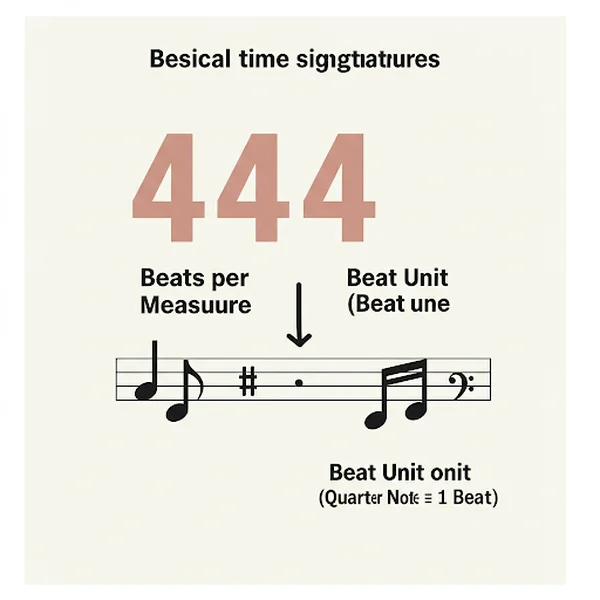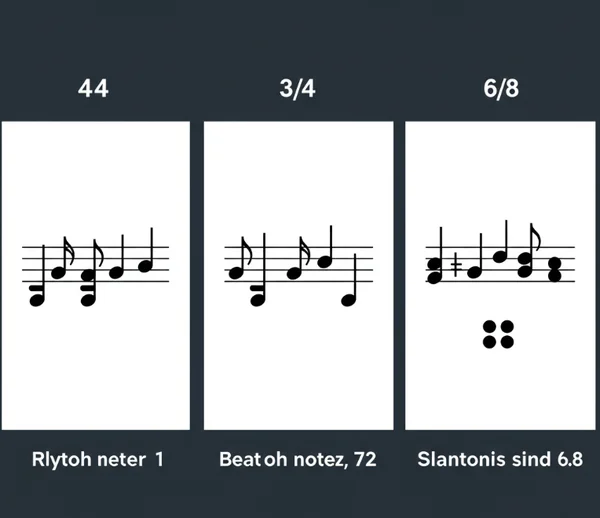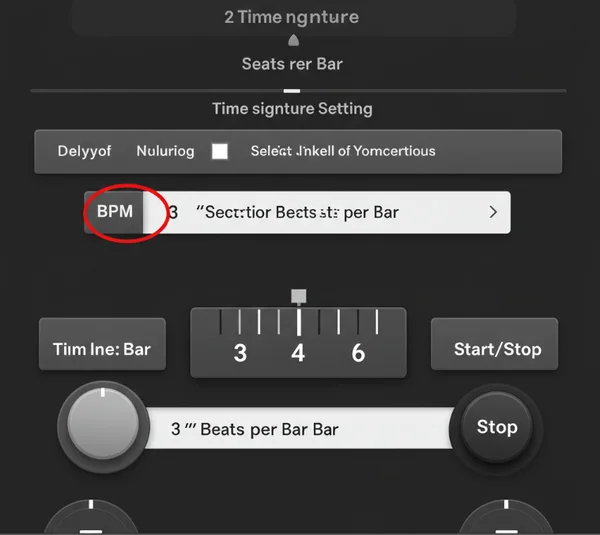Time Signatures Explained: Beginner's Guide (4/4, 3/4, 6/8)
When you first look at sheet music, those two numbers stacked at the beginning of the staff can seem like a secret code. What is time signature? It's a fundamental piece of music notation that dictates the rhythmic framework of a piece, essentially acting as its grammatical structure for rhythm. Understanding these symbols is crucial for playing music accurately and feeling the intended groove. This guide will provide a clear time signature explained breakdown, focusing on the most common ones you'll encounter – 4/4 time, 3/4 time, and 6/8 time – and show you exactly how to apply this knowledge using the metronome settings on a tool like the easy-to-use online metronome.
What Exactly IS a Time Signature? Reading the Basics
Think of a time signature as two vital pieces of information presented as a fraction (though without the line). It tells you how many beats are grouped together in each segment of music, called a measure or bar, and what kind of note gets counted as one beat. What do the numbers mean in time signature? Let's break it down.
The Top Number: Beats Per Measure
The top number is straightforward: it tells you exactly how many beats per measure there are. If the top number is 4, you count four beats before the pattern repeats (in terms of the bar line). If it's 3, you count three beats, and so on. This number organizes the musical pulse into regular groupings.
The Bottom Number: Which Note Gets the Beat
The bottom number indicates the type of note that receives one beat. It works like this:
- 4 means a quarter note (♩) gets one beat.
- 2 means a half note (♪♪ in duration, represented differently) gets one beat.
- 8 means an eighth note (♪) gets one beat.
So, a time signature like 4/4 tells you there are four beats in each measure, and the quarter note is the unit of measurement for one beat. Understanding how to read time signature notation is the first step to mastering rhythm.

Understanding 4/4 Time: The Beat of "Common Time"
This is by far the most frequently used time signature in Western music, so much so that it's often called "Common Time" and can sometimes be represented by a large "C" instead of the numbers. How to count 4/4 time? It's the steady, familiar pulse you hear in most pop, rock, country, and countless other genres.
Defining 4/4 Structure
4/4 time means:
- Top 4: There are four beats in every measure.
- Bottom 4: The quarter note (♩) gets one beat.
This structure provides a very balanced and stable rhythmic feel, making it versatile for many musical styles. It's a fundamental part of rhythm basics.
How to Count 4/4 Time (The ONE-two-three-four)
You count each measure simply as: ONE - two - three - four | ONE - two - three - four | ... The first beat usually receives the strongest beat emphasis, creating a predictable pulse. When using your online metronome, you'll hear four distinct clicks per cycle for 4/4 time.
The Feel and Use of Common Time
The feeling of 4/4 is often described as straightforward, marching, or walking. Its predictability makes it easy to follow and underlies the vast majority of songs you hear daily. Mastering this is essential for any musician.
Exploring 3/4 Time: The Rhythm of the Waltz
Often referred to as "Waltz Time", 3/4 time has a distinctly different feel from 4/4. It's graceful and flowing, immediately evoking images of ballroom dancing. How to count 3/4 time? It involves grouping beats in threes.
Defining 3/4 Structure
3/4 time means:
- Top 3: There are three beats in every measure.
- Bottom 4: The quarter note (♩) gets one beat.
This creates a cyclical feel often described as having a 'down-up-up' or 'strong-weak-weak' pattern within each measure.
How to Count 3/4 Time (The ONE-two-three)
You count each measure: ONE - two - three | ONE - two - three | ... The beat emphasis is clearly on the first beat of each group of three. When setting your metronome online tool to 3/4, listen for that three-beat pattern.
The Feel and Use of Waltz Time
The characteristic 'oom-pah-pah' sound of many waltzes comes directly from this 3/4 structure. It feels less square than 4/4, lending itself to dances, folk songs, and more lyrical musical passages.
Mastering 6/8 Time: Feeling the Compound Pulse
Now things get slightly more complex, but incredibly rewarding. 6/8 time can sometimes be confused with 3/4, but its internal feel is quite different. How to count 6/8 time? It belongs to a category called "Compound Time".
Defining 6/8 Structure (Compound Time)
6/8 time means:
- Top 6: There are six beats in every measure.
- Bottom 8: The eighth note (♪) gets one beat.
However, the crucial point about compound time signatures like 6/8 is that these six eighth notes are typically felt as two larger beats, each divided into three subdivisions (two groups of three eighth notes). Think: (1-2-3) (4-5-6).
How to Count 6/8 Time (Feeling it in Two or Six)
While you can count all six eighth notes (1-2-3-4-5-6), it's often more musically intuitive to feel the two main pulses: ONE-and-a-TWO-and-a. The emphasis naturally falls on beats 1 and 4. Your metronome practice settings might involve using subdivisions to feel this grouping clearly.
Understanding 6/8 vs 3/4
What's the difference between 6/8 and 3/4? This is a common question. While both have a 'three-ish' feel, 3/4 has three main beats (each a quarter note), often feeling like 1-2-3. 6/8 has two main beats (each a dotted quarter note, equivalent to three eighth notes), feeling more like 1-trip-let-2-trip-let. The subdivisions give 6/8 a smoother, often lilting or swinging feel compared to the more direct pulse of 3/4.
The Feel and Use of 6/8 Rhythm
6/8 time is common in jigs, lullabies, barcarolles (boat songs), and some blues and rock ballads. It has a flowing, often triple-based feel that distinguishes it clearly from simple time signatures like 4/4 and 3/4.

Setting Time Signatures on Your Online Metronome
Understanding time signatures is one thing; applying them in practice is another. Luckily, modern tools make this easy. How do I set time signature on metronome? The process on a good online metronome like the one available on this website is straightforward.
Finding the 'Beats per Bar' Setting
Look for a control labeled "Beats," "Beats per Bar," "Beats per Measure," or similar. Where is the time signature setting? On the metronome online interface, it's clearly indicated, usually near the BPM control. This setting directly corresponds to the top number of the time signature.

Adjusting for 4/4, 3/4, 6/8, and More
Simply click or select the desired number of beats per measure.
- For 4/4 time, set it to 4.
- For 3/4 time, set it to 3.
- For 6/8 time, set it to 6.
Our online metronome might also offer accent options (making the first beat louder) or subdivision settings, which are especially helpful for feeling the pulse in compound meters like 6/8. Explore these online metronome settings to enhance your practice.
Why Correct Settings Matter for Practice
Using the correct metronome settings is vital. It ensures you're internalizing the right rhythmic feel, practicing accurate counting beats, and developing a solid sense of the intended pulse and beat emphasis for the music you're learning. Don't just set the tempo; set the time signature too!
Practice Rhythms Confidently with the Right Time Signature
Decoding time signatures explained might seem daunting initially, but as we've seen, understanding the basics of 4/4, 3/4, and 6/8 opens up a much clearer path to rhythmic accuracy. Recognizing the top number as beats per measure and the bottom as the beat unit, combined with learning how to count each common type, demystifies music notation.
Mastering these isn't just about theory; it's about feeling the music correctly. Using tools like the free online metronome with the proper metronome settings allows you to internalize these different rhythmic frameworks effectively during your music practice.
Are you ready to tackle those time signatures with newfound understanding? Visit our online metronome, adjust the beats per bar, set your tempo, and start building rhythmic confidence today! Which time signature have you found most challenging to master so far?
Time Signature FAQs
-
What do the numbers mean in time signature?
The top number tells you how many beats are in each measure (bar). The bottom number tells you what kind of note gets one beat (e.g., 4 = quarter note, 8 = eighth note). It's fundamental to how to read time signature.
-
How do you properly count 6/8 time with a metronome?
While there are 6 eighth-note beats, it's often best felt in two larger beats (ONE-and-a-TWO-and-a). You can set the metronome online tool to 6 beats per bar, possibly with an accent on beats 1 and 4, or use subdivision features if available to emphasize the triplet feel within each main beat.
-
What's the main difference between 6/8 time and 3/4 time?
The main difference is the feel and grouping. 3/4 time (simple time) has three main beats, typically feeling like 1-2-3. 6/8 time (compound time) has six shorter beats but feels like two main beats, each divided into three (1-2-3 4-5-6), giving it a different, often more flowing or swinging quality.
-
How do I adjust the time signature setting on metronomeonline.org?
Look for the control labeled "Beats per Bar" or similar on the website's metronome interface. Simply select the number corresponding to the top number of the time signature you need (e.g., select '4' for 4/4, '3' for 3/4, '6' for 6/8). These online metronome settings are designed for easy access.